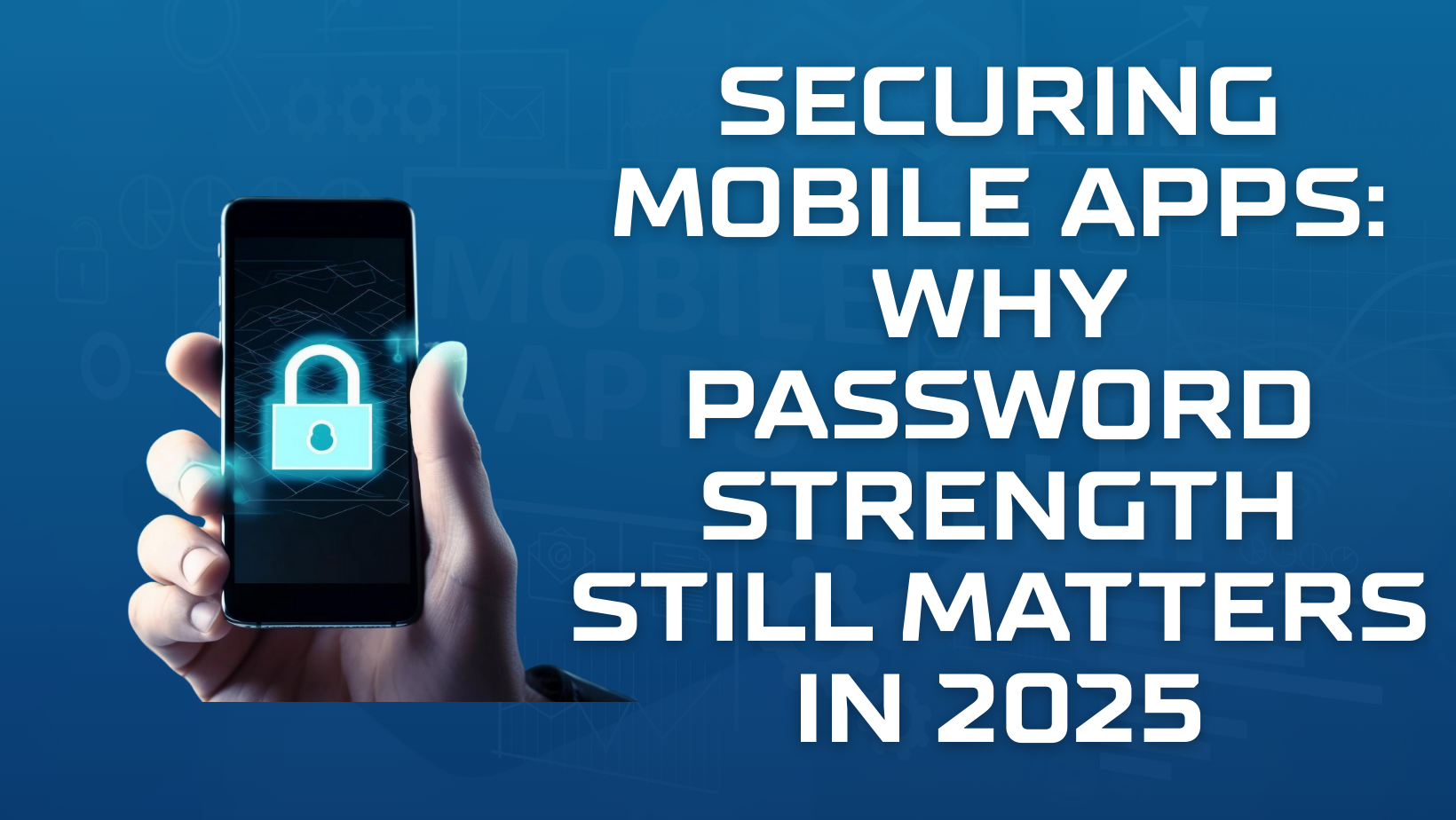Introduction
Despite advancements in biometrics, passkeys, and multi-factor authentication (MFA), passwords remain a foundational security layer for mobile apps. In 2025, 63% of data breaches still originate from weak or stolen credentials (Verizon DBIR 2025). Mobile apps are particularly vulnerable due to phishing, malware, and AI-powered brute force attacks. While newer authentication methods improve security, they often rely on passwords as a fallback. This article examines why password strength remains critical, emerging threats, and best practices for users and developers to mitigate risks.
The Role of Passwords in Mobile App Security
Why Passwords Remain Relevant Despite Advanced Authentication
Passwords persist because they are universally compatible, cost-effective, and serve as a backup when biometrics fail (e.g., fingerprint sensor errors). Many legacy systems and MFA setups still depend on passwords as the primary credential. Until passwordless authentication becomes ubiquitous, strong passwords are essential for preventing unauthorized access.
Common Weaknesses in User-Created Passwords
A 2025 Google Security Report found that 45% of users still reuse passwords, and 30% use easily guessable patterns (e.g., "123456," "Password1"). Attackers exploit these habits in credential stuffing attacks, where breached passwords are tested across multiple services.
Threat Landscape in 2025
AI-Powered Password Cracking
Modern AI tools have significantly enhanced the capability to crack passwords, with estimates suggesting that they can guess 80% of common passwords in under a minute by examining patterns derived from past data breaches. Moreover, generative AI has advanced to the point where it creates highly personalized phishing messages, increasing the likelihood of users inadvertently revealing their credentials.
Credential Stuffing & Phishing Attacks
Credential stuffing is a major concern, making up 39% of mobile app breaches as reported by OWASP in 2025. Attackers exploit this technique by automating login attempts using credentials that have been leaked. Additionally, phishing scams have evolved to closely mimic legitimate applications, further deceiving users into divulging sensitive information.
Mobile App-Specific Risks
Mobile users face a unique set of security challenges. Keyloggers, insecure Wi-Fi networks, and counterfeit app clones place them at significant risk. Weak passwords only intensify these vulnerabilities, enabling attackers to bypass encryption protections more easily.
The Psychology Behind Weak Passwords
Convenience Over Security: Many users prioritize the ease of remembering their passwords over strong security measures. A study conducted by Stanford in 2025 revealed that 60% of users avoid creating complex passwords due to the fear of forgetting them.
The Problem of Password Reuse: The practice of reusing passwords has widespread implications; a single breach can compromise multiple accounts. According to Keeper Security in 2025, 58% of users admit to recycling their passwords, exposing themselves to large-scale attacks.
How Strong Passwords Protect Mobile Apps
Brute Force Resistance: A well-crafted 12-character password, consisting of a mix of uppercase and lowercase letters, numbers, and symbols, is highly resistant to brute force attacks — potentially taking centuries to crack with current computational power.
Protection Against Automated Attacks: Strong passwords can significantly diminish the success rates of credential stuffing attacks. Applications that enforce minimum entropy thresholds are able to block up to 90% of automated login attempts, as noted in the Microsoft Security Report 2025.
Measuring Password Strength
Importance of a Password Checker: Real-time password strength meters play a vital role in promoting better password practices. Tools like Password Checker evaluate the security of user passwords by analyzing factors such as length, complexity, and uniqueness, offering immediate feedback to guide users towards adopting stronger authentication measures.
Characteristics of a Strong Password:
- Length: At least 12 characters
- Complexity: A mix of uppercase and lowercase letters, numbers, and symbols
- Unpredictability: Avoid using dictionary words and personal information
Best Practices for Creating Strong Passwords
Length and Complexity: Password length is crucial for security. Each additional character exponentially increases the difficulty of cracking it through brute-force methods. For instance, an 8-character password can be cracked in hours with modern GPU technology, whereas a 12-character password of similar complexity would require centuries.
Avoiding Common Words and Patterns: Predictable password choices render them vulnerable to dictionary attacks. Users should avoid:
- Sequential keyboard patterns (e.g., "qwerty" or "123456")
- Personal information (such as birthdates or names)
- Repeating characters (like "aaaaa")
Attackers often utilize databases of common passwords and linguistic algorithms to quickly guess these predictable passwords.
Using Passphrases: A strong alternative to traditional passwords is constructing a passphrase that combines multiple random words with numbers and symbols, making it both secure and memorable. For example:
- Weak password: "Summer2025" (highly guessable)
- Strong passphrase: "PurpleTiger$Jumps-2025!"
Tools and Technologies to Support Strong Passwords
Password Managers: Modern password management solutions provide a secure and convenient way to handle credentials. These tools generate cryptographically strong passwords automatically and store them in encrypted vaults, eliminating the human tendency to create weak passwords or reuse them across multiple accounts. By integrating with browsers and mobile devices, they enable seamless authentication while maintaining robust security. Additional features often include secure password sharing for teams, cross-platform synchronization, and real-time breach monitoring to alert users about compromised credentials.
Built-in App Security Features: Developers should focus on integrating security measures such as:
- Rate-limiting for login attempts
- Breached password detection
- Multi-Factor Authentication (MFA)
Why MFA Complements Strong Passwords
Multi-Factor Authentication can significantly thwart automated attacks, blocking 99.9% of them according to Microsoft in 2025. However, it’s essential to recognize that passwords still serve as the first line of defense.
Biometric Authentication Integration: While biometric methods like Face ID and Touch ID enhance security, they should complement—not replace—traditional passwords, as biometric data can also be spoofed.
Developer’s Responsibility in Password Security
Enforcing Strong Password Policies: Developers are encouraged to enforce strong password requirements, including:
- A minimum length of 12 characters
- Blocking known weak passwords
Secure Storage & Encryption: Employ bcrypt or scrypt hashing with salts to mitigate risks from rainbow table attacks.
The Future of Mobile App Authentication
Will Passwords Disappear? While FIDO2 passkeys are on the rise, full adoption across the industry is still years away.
Hybrid Security Approaches: The most effective security strategy involves combining passwords, biometrics, and behavioral analytics for optimal protection.
Common Myths About Password Strength
- Myth: "Changing passwords monthly improves security."
Fact: Frequent changes can lead to weaker passwords, according to NIST in 2025.
- Myth: "Special characters are enough."
Fact: Length is more critical than mere complexity.
Final Tips for Users and Developers
Users: Utilize a password manager and implement multi-factor authentication (MFA).
Developers: Enforce NIST-compliant security policies and provide education on password best practices.
Conclusion
As we approach 2025, the significance of password strength remains critical. Despite emerging authentication methods, weak passwords can compromise security measures across the board. Both users and developers must prioritize the creation and enforcement of strong, unique passwords to ensure robust protection against cyber threats.

















Post Comments